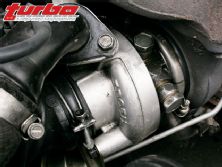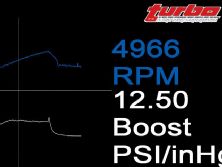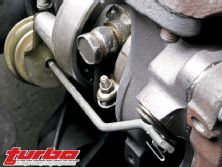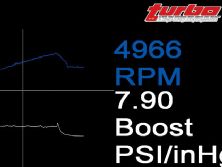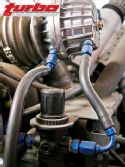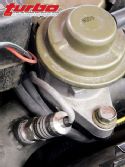 | Boost Controller - World Electronics PBC-1 Pro Boost Controller
| Boost Controller - World Electronics PBC-1 Pro Boost Controller
There's more than one way to control boost on a turbocharged car. Some methods are more expensive than the turbo they're designed to control, others cost less than the burrito I had for lunch. There are electronic ones, manual ones, and strange homologations between the two. High-tech ones enclosed in fancy looking aluminum or plastic boxes accompanied with PC linking software for things like data logging, bare bones ones that look like a shut-off valve from Home Depot, and ones that really are just a shut-off valve from Home Depot. They all work. Sort of. And unless you're regulating boost solely off the wastegate's pre-set spring, or if you have a wastegateless turbo diesel truck or something, then chances are you have some sort of boost controller already. Or at least you've been meaning to get one.
World Electronics, maker of the pricey but effective TBC-1 boost controller, now offers the newer, more affordable but equally effective PBC-1. We've had a chance to use and get used to the PBC-1 over the last several weeks on Project Laser, but before we tell you what we think of this new addition to the land of electronic boost controllers let's take a look at why you need a boost controller and the different types you can get - or make.
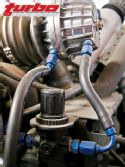 | Boost Controller - World Electronics PBC-1 Pro Boost Controller
| Boost Controller - World Electronics PBC-1 Pro Boost Controller
Aside from pulling off to the side of the road and disassembling your external wastegate to swap springs, or change out your internal wastegate actuator, using a boost controller is really the only smart way to control how much pressure your manifold sees. But they do more than that. Wastegates begin working before we need them to. Their valves typically begin to crack open once 50 percent of an engine's desired boost level is reached. Not so good. Boost controllers can keep pressure on the valve to stop this from happening, in turn, improving boost response. There are two types of boost controllers: manual and electronic. Manual controllers consist of either a ball and spring or a bleeder valve. The first uses a spring-loaded ball to temporarily block the boost reference signal the wastegate is supposed to see. Once the desired boost level is reached based on spring tension via an adjustment knob, the ball is lifted from its seat and the wastegate goes back into action. Bleeder valves are somewhat less effective and are really just a more expensive way of poking a hole in the wastegate actuator's vacuum reference line. Ball and spring controllers are fairly cheap but are unpredictable and difficult to adjust on the fly. These are best suited for vehicles looking for high boost values that a typical wastegate spring can't provide, and leaving it there. Bleeder valves are for poor people who probably can't afford the repercussions of turning up the boost anyways. Smart people can make either type.
There's really only one choice for a boost controller if you're looking for in-car, predictable adjustability, and that's an electronic one. Electronic boost controllers control the pressure signal the wastegate actuator sees by using either a stepper motor or a solenoid. Stepper motors control the opening events of the controller's valve, while solenoids either open or close the valve, quickly. Very quickly. Solenoids typically react faster than stepper motors, which means wastegate control can be even more accurate. Electronic controllers also offer digital displays in which users can punch in boost levels and the controller does the rest.
World Electronics' PBC-1 Pro Boost Controller is electronic. It also uses a solenoid, not a stepper motor. There are a few reasons why you should care about the PBC-1. First, it can control boost pressure up to 50 psi. Electronic boost controllers of past have had trouble consistently regulating even half that pressure. Second, the PBC-1 has a scramble mode that allows users up to six different boost levels. And last, the box can record up to 20 seconds of boost data for playback. While we don't have the luxury of having any vehicles here to take advantage of World's 50-psi capability, we were able to test the controller under a more mild-mannered scenario and get used to its programming and data-logging functions.
We took the opportunity to outfit our recently revived Project Laser with the PBC-1. We just installed the Big 16G turbo from Road Race Engineering and we needed a way to crank up the boost pressure, even if only a little bit. Installing World's controller consists of little more than hooking up a few wires and plumbing the solenoid into the internal wastegate's actuator signal line and the transducer to any boost source. Setup is relatively easy too. To work effectively, the PBC-1 needs to learn the vehicle's wastegate spring pressure. Doing this is easy and consists of nothing more than following a few prompts and blasting down the freeway at wide open throttle in third gear. When you're finished the controller's solenoid ends up with a duty cycle that'll ultimately work best for the indicated target boost level chosen.
Our DSM is still relatively stock, including most everything from the intake tubing and filter to the downpipe and muffler. With this in mind, especially the high exhaust gas temperatures we could expect due to the small diameter exhaust system, we opted to keep the boost at a conservative 12 psi. Instead of turning the boost way up right away, we wanted to compare 12 psi among the different scenarios the PBC-1 allows for. Same boost, but the goal here was to see what we could do about spool-up and response time by playing with the controller's features. The PBC-1 has a number of features that let you control this stuff, including ramp, duty and gain settings. Ramp controls the rate of boost without increasing the target level. For instance, we were able to increase our ramp setting to allow the 16G to have a slightly stronger initial impact as boost began to climb. In turn, this helped spool-up the turbo about 500 rpm sooner by adjusting the ramp setting by a factor of 18. This isn't the type of change you need a dyno for but is one that can actually be felt. The solenoid's duty cycle can also be adjusted. We experienced issues building full boost when on the internal wastegate's actuator alone. Even when we plumbed and wired up the PBC-1, we still weren't able to realize the full 12 psi initially. Adjusting the controller's duty cycle fixes this. The PBC-1 allows users to increase the effectiveness of the solenoid through altering its duty cycle - or how hard it works - which is exactly what we did to keep our 16G at a steady 12 psi. This is a common adjustment that can be made whenever the specified target boost level just isn't being reached. Gain can also be fine-tuned with the PBC-1. Gain is really just what happens to the boost curve after target boost pressure is " reached. By adjusting gain inside the PBC-1's unit, it's easy to alter the remaining boost curve before shifting. Play with these three settings before allowing the PBC-1 to learn your wastegate's spring pressure at your own peril. Set the target boost level first and leave everything else at zero. Adjust as necessary -in some cases you might not even need to.
Like any other electronic boost controller worth anything, the PBC-1 also has a scramble boost feature, meaning users can switch between multiple target boost settings - including ramp, gain and duty cycle for each stage - via an external momentary switch. Six stages, one switch. The switch can be located anywhere from a clutch pedal for hands-free, gear-based boost changes, to a shift knob. World's electronic boost controller also features a simple yet effective boost data logger built in to the controller. Press the control-mounted record button and up to 20 seconds of boost and time data can be stored within the controller for playback. This can be an especially useful feature for diagnosing sudden boost dips and spikes if you don't have access to expensive data logging equipment.
Most of the time, there's little to differentiate one electronic boost controller from the next besides price, colors and buttons. But the PBC-1 has a few features that help it stand out. We think its best feature is just how intuitive it is when it comes to learning the wastegate's spring pressure. We were impressed with how little tuning we needed to do to get boost stabilized where we wanted it. In total, we logged in roughly a dozen passes to get it all dialed in. Tuning time was also cut down, in part, because of the controller's built-in boost logging function. This allowed us to avoid the usual 80 mph boost gauge read and instead view our results safely pulled off to the side of the road. Try doing that with your Home Depot shut-off valve.

